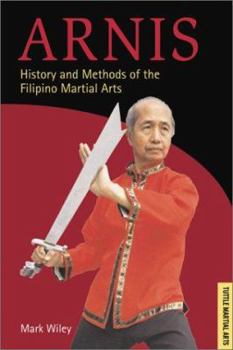Arnis: History and Methods of the Filipino Martial Arts
This is the story of the Filipino martial arts tradition, including its history, cultural perspective, and technique. The book examines training regimens, fighting techniques, and innovations,... This description may be from another edition of this product.
Format:Paperback
Language:English
ISBN:0804832692
ISBN13:9780804832694
Release Date:June 2001
Publisher:Tuttle Publishing
Length:182 Pages
Weight:0.70 lbs.
Dimensions:0.6" x 6.1" x 9.0"
Related Subjects
Asia Individual Sports Martial Arts Philippines Sports & Outdoors Sports & RecreationCustomer Reviews
3 ratings
overall a worthwile read
Published by Thriftbooks.com User , 20 years ago
There is so much information that I read this book in a week. The other reviews of this book are correct. What I came away with this book is that Filipino martial arts(FMA)is hardly in danger of extinction although it is probably practiced by not a great number of people. It came as a surprise to me that some universities in the Philippines have FMA in their curriculum. There are gems in this book, for instance it identifies the earliest published book in the subject which is a tract entitled "Mga Karunungan sa Larung Arnis" roughly translated means "A Body of Knowledge in the Game of Arnis", it was written sometime in the 1950s. A book like this is appropriate for discussing FMA. A how-to book would not be instructive by the very fact that mere pictures cannot encapsulate the essence of the various movements. In early book on the subject Danny Inosanto wrote about it, in his book the most useful parts are the stories of the Grandmasters and history of FMA, and not the instruction with pictures. FMA can only be learned through corporal instruction, that is because FMA is a social martial art. That means that you are only as good as the people you are around you, that includes practitioners who you can steal knowledge from.I do have some misgivings about this book and that is when they discuss FMA in the United States, they only focus on California, particularly Stockton. They leave out the vibrant FMA community in Hawaii, which is very much a Mecca as Stockton is. They even cover the distant FMA communities in Europe and ignore Hawaii where many grandmasters reside.
Collection of Academic Filipino Martial Arts Articles...
Published by Thriftbooks.com User , 22 years ago
Be advised there are no pictures in this book, it is an academic undertaking. If you are looking for something with visual historical material in it, try the two books authored by Mark Wiley: "Filipino Martial Culture" and "Filipino Fighting Arts: Theory and Practice".The placment of Mark Wiley's name on the front cover suggests he is the AUTHOR, where he is in fact, the EDITOR of this collection of articles (he is also a contributor). Not Wiley's fault--he credits the collective group in the introduction. Small point that only matters to us fans of footnotes, I know...now, on to assessing this collection of articles!In Part 1, writers offer perspectives on the origins of the Filipino arts, including five articles such as "A Question of origins", by Felipe Jocano, Jr., and "Questioning the Origins of Escrima", by Dr. Ned Nepangue, etc.. Part 2 focuses on Historical Perspectives with five offerings like "A History of Eskrima in Cebu and Negros", by Krishna Godhania. Part 3, Cultural Perspectives, includes eight articles by different contributors, including "Passion from the Crescent Moon" by Marilitz Dizon, and "The Making of the Batangas (Balisong) Knife" by Dr. Jopet Laraya. Part 4, Facing The Future, includes three articles including Combative vs. Competitive Escrima by Krishna Godhania, and "The Implimentation of Arnis in the Physical Education programs of Tertiary Schools in Cebu City" by Abner G. Pasa.Overall, this is a good collection of topics of a calibre more advanced than most newsstand martial arts magazines could tolerate. The tone is clearly academic in nature, although less than half of the article include notes of some sort at their conclusion. Wiley does include a well-rounded list of source materials for further reading. If you are tired of how-to manuals, here is a book which will present new information, even for those of us who have pretty well "been around the block" when it comes to learning about other cultures and practice. The variety of perspectives are insightful.
Well worth a read for FMA practioners.
Published by Thriftbooks.com User , 23 years ago
Be aware, the "editiorial comments" above do not accurately reflect the content of this book; I suspect they are based on another of Mark Wiley's books.There are no pictures in this book. This book is actually a collection of articles about various aspects of the history and development of FMA. Some of them are new and some have been taken from the pages of Rapid Journal (published in the Phillipines). Some of the articles are written by well known people on the FMA such as: Tony Somers, Krishna Godhania and Mark Wiley, other names are new to me.As the title suggests, the articles are about the history of the arts, not the technical side and as such this volume fills a gap in the reading of most practioners.On the down side, some of the articles are very thin; it hardly seems worth while to have bothered with the item on the history of FMA in Europe.(This is a real contrast to some of the others).I enjoyed the book, but was left wanting more.JB






